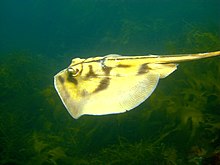| Urolophus | |
|---|---|

| |
| Urolophus cruciatus | |
| Scientific classification | |
| Domain: | Eukaryota |
| Kingdom: | Animalia |
| Phylum: | Chordata |
| Class: | Chondrichthyes |
| Subclass: | Elasmobranchii |
| Superorder: | Batoidea |
| Order: | Myliobatiformes |
| Family: | Urolophidae |
| Genus: | Urolophus J. P. Müller & Henle, 1837 |
| Type species | |
| Raja cruciata Lacepède, 1804
| |
Urolophus is a genus of round rays mostly native to the western Pacific Ocean and the Indian Ocean, though one species occurs in the Pacific waters of the Mexican coast. Müller and Henle erected Urolophus in an 1837 issue of Bericht Akademie der Wissenschaften zu Berlin.[1] The name is derived from the Greek oura, meaning "tail", and lophos, meaning "crest".[2] In Urolophus, the outer rims of the nostrils are not enlarged into lobes, but may form a small knob at the back.[3]
A fossil species, Urolophus crassicaudatus, has been found in Monte Bolca, northern Italy, in deposits dating back to the late Ypresian stage of the Eocene epoch (49 Ma);[4] however, Marramà et al. (2020) transferred this species to the genus Arechia.[5]
Species
[edit]There are currently 21 recognized species in this genus:
- Urolophus aurantiacus J. P. Müller & Henle, 1841 (Sepia stingray)
- †Urolophus bicuneatus Noetling, 1885
- Urolophus bucculentus W. J. Macleay, 1884 (Sandyback stingaree)
- Urolophus circularis McKay, 1966 (Circular stingaree)
- Urolophus cruciatus Lacepède, 1804 (Crossback stingaree)
- Urolophus deforgesi Séret & Last, 2003 (Chesterfield Island stingaree)
- Urolophus expansus McCulloch, 1916 (Wide stingaree)
- Urolophus flavomosaicus Last & M. F. Gomon, 1987 (Patchwork stingaree)
- Urolophus gigas T. D. Scott, 1954 (Spotted stingaree)
- †Urolophus javanicus E. von Martens, 1864 (Java stingaree)
- Urolophus kaianus Günther, 1880 (Kai stingaree)
- Urolophus kapalensis Yearsley & Last, 2006 (Kapala stingaree)
- Urolophus lobatus McKay, 1966 (Lobed stingaree)
- Urolophus mitosis Last & M. F. Gomon, 1987 (Mitotic stingaree)
- Urolophus neocaledoniensis Séret & Last, 2003 (New Caledonian stingaree)
- Urolophus orarius Last & M. F. Gomon, 1987 (Coastal stingaree)
- Urolophus papilio Séret & Last, 2003 (Butterfly stingaree)
- Urolophus paucimaculatus J. M. Dixon, 1969 (Sparsely-spotted stingaree)
- Urolophus piperatus Séret & Last, 2003 (Coral Sea stingaree)
- Urolophus sufflavus Whitley, 1929 (Yellowback stingaree)
- Urolophus viridis McCulloch, 1916 (Greenback stingaree)
- Urolophus westraliensis Last & M. F. Gomon, 1987 (Brown stingaree)
See also
[edit]References
[edit]- ^ Müller, J. & Henle, F.G.J. (1837). "Gattungen der Haifische und Rochen nach einer von ihm mit Hrn. Henle unternommenen gemeinschaftlichen Arbeit über die Naturgeschichte der Knorpelfische". Bericht Akademie der Wissenschaften zu Berlin. 1837: 111–118.
- ^ Froese, Rainer and Pauly, Daniel, eds. (2015). Species of Urolophus in FishBase. February 2015 version.
- ^ Yearsley, G.K. & Last, P.R. (2006). "Urolophus kapalensis sp. nov., a new stingree (Myliobatiformes: Urolophidae) off eastern Australia". Zootaxa. 1176: 41–52. doi:10.11646/zootaxa.1176.1.4.
- ^ G. Carnevale, A. F. Bannikov, G. Marramá, J. C. Tyler, and R. Zorzin. 2014. The Pesciara-Monte Postale Fossil-Lagerstätte: 2. Fishes and other vertebrates. Rendiconti della Società Paleontologica Italiana 4:37–63.
- ^ Giuseppe Marramà; Giorgio Carnevale; Gavin J. P. Naylor; Jürgen Kriwet (2020). "Skeletal anatomy, phylogenetic relationships, and paleoecology of the Eocene urolophid stingray Arechia crassicaudata (Blainville, 1818) from Monte Postale (Bolca Lagerstätte, Italy)". Journal of Vertebrate Paleontology. 40 (4): e1803339. Bibcode:2020JVPal..40E3339M. doi:10.1080/02724634.2020.1803339.
Well, that’s interesting to know that Psilotum nudum are known as whisk ferns. Psilotum nudum is the commoner species of the two. While the P. flaccidum is a rare species and is found in the tropical islands. Both the species are usually epiphytic in habit and grow upon tree ferns. These species may also be terrestrial and grow in humus or in the crevices of the rocks.
View the detailed Guide of Psilotum nudum: Detailed Study Of Psilotum Nudum (Whisk Fern), Classification, Anatomy, Reproduction